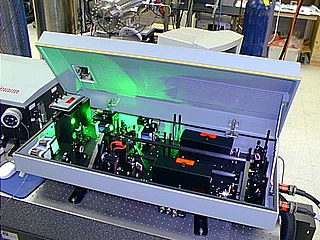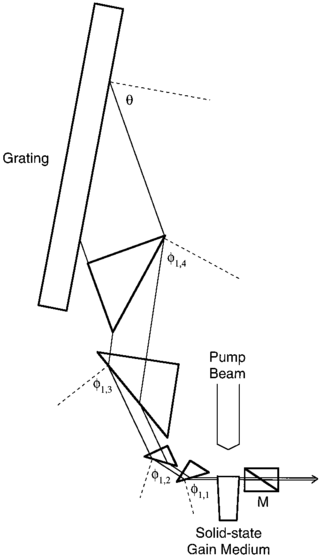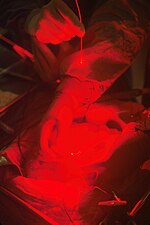
A laser is a device that emits light through a process of optical amplification based on the stimulated emission of electromagnetic radiation. The word laser is an anacronym that originated as an acronym for light amplification by stimulated emission of radiation. The first laser was built in 1960 by Theodore Maiman at Hughes Research Laboratories, based on theoretical work by Charles H. Townes and Arthur Leonard Schawlow.
Intense pulsed light (IPL) is a technology used by cosmetic and medical practitioners to perform various skin treatments for aesthetic and therapeutic purposes, including hair removal, photorejuvenation as well as to alleviate dermatologic diseases such as acne. IPL is increasingly used in optometry and ophthalmology as well, to treat evaporative dry eye disease due to meibomian gland dysfunction.

A dye laser is a laser that uses an organic dye as the lasing medium, usually as a liquid solution. Compared to gases and most solid state lasing media, a dye can usually be used for a much wider range of wavelengths, often spanning 50 to 100 nanometers or more. The wide bandwidth makes them particularly suitable for tunable lasers and pulsed lasers. The dye rhodamine 6G, for example, can be tuned from 635 nm (orangish-red) to 560 nm (greenish-yellow), and produce pulses as short as 16 femtoseconds. Moreover, the dye can be replaced by another type in order to generate an even broader range of wavelengths with the same laser, from the near-infrared to the near-ultraviolet, although this usually requires replacing other optical components in the laser as well, such as dielectric mirrors or pump lasers.
The term biophotonics denotes a combination of biology and photonics, with photonics being the science and technology of generation, manipulation, and detection of photons, quantum units of light. Photonics is related to electronics and photons. Photons play a central role in information technologies, such as fiber optics, the way electrons do in electronics.

Nd:YAG (neodymium-doped yttrium aluminum garnet; Nd:Y3Al5O12) is a crystal that is used as a lasing medium for solid-state lasers. The dopant, triply ionized neodymium, Nd(III), typically replaces a small fraction (1%) of the yttrium ions in the host crystal structure of the yttrium aluminum garnet (YAG), since the two ions are of similar size. It is the neodymium ion which provides the lasing activity in the crystal, in the same fashion as red chromium ion in ruby lasers.

A gas laser is a laser in which an electric current is discharged through a gas to produce coherent light. The gas laser was the first continuous-light laser and the first laser to operate on the principle of converting electrical energy to a laser light output. The first gas laser, the Helium–neon laser (HeNe), was co-invented by Iranian engineer and scientist Ali Javan and American physicist William R. Bennett, Jr., in 1960. It produced a coherent light beam in the infrared region of the spectrum at 1.15 micrometres.

A tunable laser is a laser whose wavelength of operation can be altered in a controlled manner. While all laser gain media allow small shifts in output wavelength, only a few types of lasers allow continuous tuning over a significant wavelength range.

Atomic vapor laser isotope separation, or AVLIS, is a method by which specially tuned lasers are used to separate isotopes of uranium using selective ionization of hyperfine transitions. A similar technology, using molecules instead of atoms, is molecular laser isotope separation (MLIS).
Amplified spontaneous emission (ASE) or superluminescence is light, produced by spontaneous emission, that has been optically amplified by the process of stimulated emission in a gain medium. It is inherent in the field of random lasers.
Laser surgery is a type of surgery that uses a laser to cut tissue.
Photomedicine is an interdisciplinary branch of medicine that involves the study and application of light with respect to health and disease. Photomedicine may be related to the practice of various fields of medicine including dermatology, surgery, interventional radiology, optical diagnostics, cardiology, circadian rhythm sleep disorders and oncology.
Roy G. Geronemus is an American dermatologist in the field of laser treatment of skin disorders.
Photorejuvenation is a skin treatment that uses lasers, intense pulsed light, or photodynamic therapy to treat skin conditions and remove effects of photoaging such as wrinkles, spots, and textures. The process induces controlled wounds to the skin. This prompts the skin to heal itself, by creating new cells. This process—to a certain extent—removes the signs of photoaging. The technique was invented by Thomas L Roberts, III using CO2 lasers in the 1990s. Observed complications have included scarring, hyperpigmentation, acne, and herpes.

Francisco Javier "Frank" Duarte is a laser physicist and author/editor of several books on tunable lasers.
Beam expanders are optical devices that take a collimated beam of light and expand its width.

A solid-state dye laser (SSDL) is a solid-state lasers in which the gain medium is a laser dye-doped organic matrix such as poly(methyl methacrylate) (PMMA), rather than a liquid solution of the dye. These lasers are also referred to as solid-state organic lasers and solid-state dye-doped polymer lasers.

Multiple-prism grating laser oscillators, or MPG laser oscillators, use multiple-prism beam expansion to illuminate a diffraction grating mounted either in Littrow configuration or grazing-incidence configuration. Originally, these narrow-linewidth tunable dispersive oscillators were introduced as multiple-prism Littrow (MPL) grating oscillators, or hybrid multiple-prism near-grazing-incidence (HMPGI) grating cavities, in organic dye lasers. However, these designs were quickly adopted for other types of lasers such as gas lasers, diode lasers, and more recently fiber lasers.
Leon Goldman was an American dermatologist and a pioneer in laser medicine. His research areas included the application of lasers in dermatology, cancer photodynamic therapy (PDT) and the use of organic dyes in PDT.









